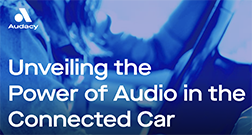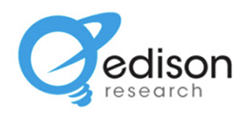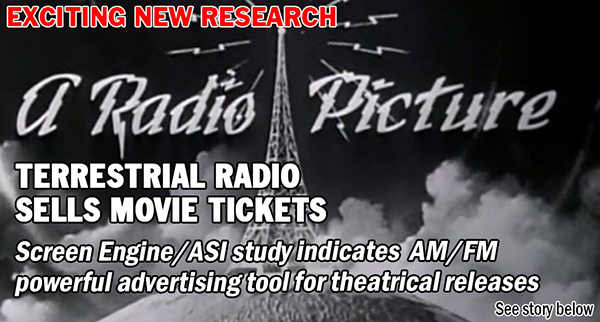By Bill Bartholomew
Talk Host/Podcaster/Journalist/Musician
 Folks in the Gen Z and millennial demographics are heavily engaged in political issues, care about news in their communities and the world, and are constantly bombarded with content. So why are they less likely to tune into and interact with news/talk radio than older demographics?
Folks in the Gen Z and millennial demographics are heavily engaged in political issues, care about news in their communities and the world, and are constantly bombarded with content. So why are they less likely to tune into and interact with news/talk radio than older demographics?
Talk radio has historically skewed older, and from an ad portfolio standpoint, is often targeted at the coveted 35-54 and 55+ demographics. However, in a world where social media influencers and podcasters supply information to millions of young consumers, news/talk radio should be able to effectively compete for the ears of younger generations in a comparable, if not expanded way.
For all of the anecdotal and hard evidence that terrestrial radio may be trending in a downward direction, the format continues to have a vast reach. It is convenient to engage with it in automobiles, and occasionally in home or office settings. Yet, while younger generations listen to radio, news/talk is not the format that they turn to by and large.
Unlike many digital-first content producers, radio retains a unique quality: authority. By virtue of editorial standards, FCC regulation and brand – things that social media and podcasts often lack – radio has the unique ability to deliver credible, vetted, nuanced and universally trustworthy content that can instantaneously adapt to meet the needs of the moment. This is true in everything from natural disasters to rapidly evolving breaking news stories, providing a channel for immediate, reactionary insight and analysis.
There are several steps that news/talk radio should pursue in earnest to adapt to the current climate of content consumption, particularly by younger listeners, that can reach, and most importantly, retain broader, younger, more diverse and more engaged audiences.
- Introduce younger people into the conversation.
Too often, Gen Z and millennials are skewered by older hosts, mocked for their perceived naivety, unchecked optimism and me-first approach. While some of these qualities can be accurate, that approach reflects a disconnect between older generations and the experience of younger ones. Millennials and Gen Z have grown up in a post-9/11 world replete with “endless wars”, the fallout from the 2008 financial crisis, runaway student debt, a massive housing crisis, the mental health stressors of social media, Covid19’s impact on traditional youth experiences, climate change, a deeply bifurcated political environment and a constantly evolving quest for social justice. Through these experiences, younger generations offer an important perspective that should be assigned the same news value as experts from older generations.
Are you discussing shifts towards electric vehicles? Bring on someone from Gen Z to share their perspective on why steps towards carbon neutrality are important to them. Engaging a conversation on the president’s approval rating? Perhaps younger conservative and leftist voices should be included in the conversation. Discussing immigration? How about the perspective of a younger member of a Latino organization?
By giving younger generations and more diverse guests a platform, stations can simultaneously expand their content and reach. With consistency, the station’s brand will become more familiar to younger potential listeners who may be inclined to tune in to hear someone who shares their identity and perspective on – here’s that word again – a platform of authority. Let the guest do the work of establishing the credibility and importance of your station or talk show to younger audiences by posting about their appearance on social media, sharing audio clips and mentioning to their peers. It will build familiarity and trust among those generations, who in turn, will begin to tune in on a more regular basis.
Stations should also consider bringing more younger, competent voices into on-air roles, whether that be through reporting, segments, fill-in hosts, weekend shows or full-time hosts.
- Meet the audience where they are: their phones.
As mentioned above, the convenience of simply turning on AM/FM radio is highly appealing in automobiles, though as Apple Carplay continues to adapt and evolve, digital-first content is likely to become as simple and convenient in the near future.
Talk radio needs to make consuming their product on smartphones as simple and direct as turning on a traditional radio. This means no clunky websites, no lengthy pre-roll spots, a reliable stream connection and a “one touch” means of turning on and off the station. This should also mean expanding talk shows to high-quality video livestreams, following in the footsteps of the top YouTube and Twitch performers; developing unique content for TikTok and Instagram; building podcasts that are focused on specific issues, and; providing interaction via text and chat.
Radio has the ability to be the ultimate livestreamer, social media influencer and podcaster, but rarely harnesses these platforms in a meaningful way.
It is not enough to simply strive to “expand a digital presence”; stations and shows must engage in the hard work of building platform-specific content with their brands.
- Music, cultural references and themes for the modern age.
A few weeks ago on a seemingly benign episode of the TV show FOX NFL Sunday, panelists Jimmy Johnson and Terry Bradshaw offered an example of the type of cultural adaptation that sophisticated writers and producers provide their brands. While describing a fight between two football players, Mr. Johnson said something to the effect of “when it comes to these two, what’s that Taylor Swift song?”, and then in synch with Mr. Bradshaw, “bad blood!”. It is highly unlikely that these two 70+ men listen to Taylor Swift’s music with any regularity or would simultaneously pull the “Bad Blood” reference. Yet, with excellent preparation that played into the greater cultural moment as well as the specific, current Taylor Swift/NFL overlap, in a six-second span, FOX NFL Sunday was able to give the illusion that their panelists are contemporary, hip and plugged into “what is going on”. Is your station or show plugged into what’s going on? Do you use contemporary music for bumps? Are your images – including headshots and social content – modern, interesting and engaging or are they more akin to a miscellaneous real estate agent? You are a performer in an entertainment business that, while certainly paying homage to the past and lineage of the industry, must be contemporary in aural and visual presentation. This goes for everything from wardrobe on video and in photo to fonts on graphic design.
How often do you or your producer read Pitchfork to learn about new music that is breaking this week? How often do you or your producer read Variety to understand major trends that are happening in the broader entertainment industry? What live events are you broadcasting from, covering and building partnerships with? You should strive to be cutting edge.
- We need a friend now more than ever.
This is something that goes for all audiences, but particularly for younger ones. It’s OK, in fact, great to be yourself, present yourself from your generation and retain the authoritative stance that has built your brand. Take a look at the success that sports talker Mike Francesa enjoyed by leaning into his persona – and in turn – developing legions of younger listeners that fell in love with his dad-like delivery and frequent meltdowns.
Few things are as uncomfortable to see as a 40+ person dressing or acting like a teenager. Younger listeners want that senior, experienced, trusted friend to entertain them, inform them, and at times, tell them that everything is going to be OK. You can help make sense of the world for younger audiences, something that is absolutely essential in the modern era.
Through attracting younger listeners by including them in the conversation, effectively delivering content on smartphones, presenting a cutting-edge entertainment product and continuing to serve as a trusted friend, news/talk radio can greatly expand its reach, relevance and revenue.
To that point, some younger listeners who discover a radio station or show via any of the above entry points will likely work backwards to the traditional AM/FM dial. Like the resurgence of vinyl records, AM radio in particular has the opportunity to become a hip delivery format for discerning younger listeners.
The big question is: are radio companies, stations and hosts prepared to do the hard work of reimaging their product?
Share this with your network
 media budget, adding AM/FM radio to a digital/TV plan sharply builds reach. Via Nielsen Commspoint, the media allocation planning tool, a wide range of monthly digital/TV media plans were examined. Very small, light, medium, and heavy campaigns were examined. The lightest digital/TV campaign reached 10% of the market. The heaviest reached 60%. Then a 20% allocation of AM/FM radio was introduced. The results were stunning. Across the seven monthly campaigns, from the lightest to the heaviest, the addition of AM/FM radio generated significant lifts in reach. Shifting 20% of the lightest TV/digital campaign to AM/FM radio caused reach to double. Introducing the 20% allocation of AM/FM radio to medium-sized campaigns causes reach to soar by 36% to 55%. Even the heaviest TV and digital campaign saw reach grow 20% with the addition of AM/FM radio to the plan.” Read the full blog post here.
media budget, adding AM/FM radio to a digital/TV plan sharply builds reach. Via Nielsen Commspoint, the media allocation planning tool, a wide range of monthly digital/TV media plans were examined. Very small, light, medium, and heavy campaigns were examined. The lightest digital/TV campaign reached 10% of the market. The heaviest reached 60%. Then a 20% allocation of AM/FM radio was introduced. The results were stunning. Across the seven monthly campaigns, from the lightest to the heaviest, the addition of AM/FM radio generated significant lifts in reach. Shifting 20% of the lightest TV/digital campaign to AM/FM radio caused reach to double. Introducing the 20% allocation of AM/FM radio to medium-sized campaigns causes reach to soar by 36% to 55%. Even the heaviest TV and digital campaign saw reach grow 20% with the addition of AM/FM radio to the plan.” Read the full blog post here. 


 content, providing an accurate assessment of the audience’s attentiveness and engagement.” Some of the key findings include: 1) Despite lacking “sight, sound, and motion,” AM/FM radio programming was +13% more engaging than Mediaprobe’s norm for television in the U.S. For advertisers, this means the AM/FM radio context for their ads has greater engagement than the TV context; 2) Overall, AM/FM radio advertising’s Emotional Impact Score (EIS) outperformed TV advertising by +12%. These new findings validate the recently released Dentsu/Lumen study, which revealed audio ads outperform video for attention and brand recall; 3) AM/FM radio news was the most impactful genre, consistently measuring as a high-quality contextual environment for advertising (+14% greater than Mediaprobe TV News norms and +8% than total AM/FM radio); 4) Mediaprobe audio benchmarks reveal the sound contrast between AM/FM radio programming and the ads drives higher attention and brand recall. For example, ads with music and jingles perform very well in spoken word programming due to the contrast; and 5) Creative best practices: Use female voiceovers, jingles, and include five brand mentions.
content, providing an accurate assessment of the audience’s attentiveness and engagement.” Some of the key findings include: 1) Despite lacking “sight, sound, and motion,” AM/FM radio programming was +13% more engaging than Mediaprobe’s norm for television in the U.S. For advertisers, this means the AM/FM radio context for their ads has greater engagement than the TV context; 2) Overall, AM/FM radio advertising’s Emotional Impact Score (EIS) outperformed TV advertising by +12%. These new findings validate the recently released Dentsu/Lumen study, which revealed audio ads outperform video for attention and brand recall; 3) AM/FM radio news was the most impactful genre, consistently measuring as a high-quality contextual environment for advertising (+14% greater than Mediaprobe TV News norms and +8% than total AM/FM radio); 4) Mediaprobe audio benchmarks reveal the sound contrast between AM/FM radio programming and the ads drives higher attention and brand recall. For example, ads with music and jingles perform very well in spoken word programming due to the contrast; and 5) Creative best practices: Use female voiceovers, jingles, and include five brand mentions.  audio experienced a 17% decline. The study identified radio app and voice users as super users who shared common traits and expectations. Audacy notes, “These highly engaged individuals demand seamless transitions for Audio across their home, phone, and car systems… Moreover, they exhibit readiness to spend, particularly in high-budget categories like home improvement and financial services, responding actively to targeted radio ads. For advertisers, crafting personalized ads targeted at these audiences presents an exceptional opportunity to guide listeners through all stages of the purchase funnel.” Other key findings of the study include: 1) Nearly half of radio app users sought information about advertised products online after hearing an ad in the car, compared to 22% of all listeners; 2) 31% of radio app users and 27% of voice users visited the store they heard about, doubling the rate of all listeners; and 3) 27% of radio app users purchased advertised products, more than doubling the rate of all listeners.
audio experienced a 17% decline. The study identified radio app and voice users as super users who shared common traits and expectations. Audacy notes, “These highly engaged individuals demand seamless transitions for Audio across their home, phone, and car systems… Moreover, they exhibit readiness to spend, particularly in high-budget categories like home improvement and financial services, responding actively to targeted radio ads. For advertisers, crafting personalized ads targeted at these audiences presents an exceptional opportunity to guide listeners through all stages of the purchase funnel.” Other key findings of the study include: 1) Nearly half of radio app users sought information about advertised products online after hearing an ad in the car, compared to 22% of all listeners; 2) 31% of radio app users and 27% of voice users visited the store they heard about, doubling the rate of all listeners; and 3) 27% of radio app users purchased advertised products, more than doubling the rate of all listeners.  aggressive AM/FM streaming app acquisition strategy by negotiating with three targets simultaneously. It is now clear that market conditions are unfavorable for securing the largest acquisition as our first target. As such, to optimize shareholder value we are withdrawing the current S-1 on file that contemplates the Radio FM acquisition.”
aggressive AM/FM streaming app acquisition strategy by negotiating with three targets simultaneously. It is now clear that market conditions are unfavorable for securing the largest acquisition as our first target. As such, to optimize shareholder value we are withdrawing the current S-1 on file that contemplates the Radio FM acquisition.” those living in suburban or urban areas. Rural listeners spend 43% of their daily audio listening time with AM/FM radio and radio streams, compared with urban listeners who spend 34% of their time with AM/FM radio and radio streams. Meanwhile, Urban listeners spend over twice as much of their daily audio time with podcasts as rural listeners. Urban listeners spend 13% of their daily audio time with podcasts compared with rural listeners who spend 6% of their daily time with podcasts.” Interestingly, if you combine the AM/FM listening and podcast listening numbers for Urban, Suburban and Rural listeners, these numbers are essentially the same – between 47% and 49%. Edison notes, “It appears that the ‘time budget’ for radio and podcasting combined is consistent across locations; it is just the apportionment of that time that varies.”
those living in suburban or urban areas. Rural listeners spend 43% of their daily audio listening time with AM/FM radio and radio streams, compared with urban listeners who spend 34% of their time with AM/FM radio and radio streams. Meanwhile, Urban listeners spend over twice as much of their daily audio time with podcasts as rural listeners. Urban listeners spend 13% of their daily audio time with podcasts compared with rural listeners who spend 6% of their daily time with podcasts.” Interestingly, if you combine the AM/FM listening and podcast listening numbers for Urban, Suburban and Rural listeners, these numbers are essentially the same – between 47% and 49%. Edison notes, “It appears that the ‘time budget’ for radio and podcasting combined is consistent across locations; it is just the apportionment of that time that varies.” small attributed lift (0% to +3% lift) to excellent (+15% or more). Across the 17 campaigns analyzed, the average attributed lift was +14%. Three tax preparation service campaigns achieved “excellent” status ranging from a +30% to +48% attributed lift; 2) On average, the 17 AM/FM radio campaigns saw the highest percentage of impressions at the start of the week, peaking on Mondays and Tuesdays. Compared to the Nielsen impressions, the AM/FM radio campaigns outperformed on Saturday, Sunday, and Monday. Advertisers should increase their use of AM/FM radio on the weekends. AM/FM radio campaigns on weekends drive impact and results; and 3) On average, evenings have a greater share of attributed web sessions due to available devices and free time of consumers. Mornings historically underdeliver their share of impressions since consumers are busy getting ready for work and school. This expected pattern should not be a reason to move campaign weight out of morning drive. Morning drive exposure results in web sessions during later dayparts when consumers have the time and available devices to respond.
small attributed lift (0% to +3% lift) to excellent (+15% or more). Across the 17 campaigns analyzed, the average attributed lift was +14%. Three tax preparation service campaigns achieved “excellent” status ranging from a +30% to +48% attributed lift; 2) On average, the 17 AM/FM radio campaigns saw the highest percentage of impressions at the start of the week, peaking on Mondays and Tuesdays. Compared to the Nielsen impressions, the AM/FM radio campaigns outperformed on Saturday, Sunday, and Monday. Advertisers should increase their use of AM/FM radio on the weekends. AM/FM radio campaigns on weekends drive impact and results; and 3) On average, evenings have a greater share of attributed web sessions due to available devices and free time of consumers. Mornings historically underdeliver their share of impressions since consumers are busy getting ready for work and school. This expected pattern should not be a reason to move campaign weight out of morning drive. Morning drive exposure results in web sessions during later dayparts when consumers have the time and available devices to respond.  from the study include: 1) the proportion of AM/FM radio in-car listening rose 9% year-over-year and is on par with pre-pandemic levels of listening; 2) spoken-word content listening is at an eight-year high with 39% of ad-supported listening (including AM/FM, streaming and podcasts) devoted to news/talk, talk, and sports; and 3) looking at Persons 25-54, the share of ad-supported audio time spent with personalities/talk shows has increased the most – from 11% of ad-supported listening in Q4 2016 to 19.4% in Q3 of 2023.
from the study include: 1) the proportion of AM/FM radio in-car listening rose 9% year-over-year and is on par with pre-pandemic levels of listening; 2) spoken-word content listening is at an eight-year high with 39% of ad-supported listening (including AM/FM, streaming and podcasts) devoted to news/talk, talk, and sports; and 3) looking at Persons 25-54, the share of ad-supported audio time spent with personalities/talk shows has increased the most – from 11% of ad-supported listening in Q4 2016 to 19.4% in Q3 of 2023.  AM/FM radio listeners are 39% more likely to pay $301+ to have their taxes prepared and show greater familiarity, interest, consideration, and usage of tax category brands; 2) AM/FM radio ads drive site traffic for tax preparation brands: In the LeadsRx attribution study of a tax preparation service’s multi-wave campaign, AM/FM radio generated between a 43% to 47% increase in website traffic; 3) Branding early and often in tax preparation service ads drives more site traffic: LeadsRx found the top three creative executions that drove site traffic for a tax preparation service had the marketer’s brand name within the first five seconds of the ad; and 4) compared to other radio formats, a 2023 tax prep campaign on news/talk and sports stations realized a higher percentage share of interactions than the percentage share of their Nielsen ad impressions.
AM/FM radio listeners are 39% more likely to pay $301+ to have their taxes prepared and show greater familiarity, interest, consideration, and usage of tax category brands; 2) AM/FM radio ads drive site traffic for tax preparation brands: In the LeadsRx attribution study of a tax preparation service’s multi-wave campaign, AM/FM radio generated between a 43% to 47% increase in website traffic; 3) Branding early and often in tax preparation service ads drives more site traffic: LeadsRx found the top three creative executions that drove site traffic for a tax preparation service had the marketer’s brand name within the first five seconds of the ad; and 4) compared to other radio formats, a 2023 tax prep campaign on news/talk and sports stations realized a higher percentage share of interactions than the percentage share of their Nielsen ad impressions.  Survey says nearly half of all Americans over 13, nearly 135 million, listen to spoken word formats. The growth curve boasts an eye opening 52% jump in time spent listening at home.
Survey says nearly half of all Americans over 13, nearly 135 million, listen to spoken word formats. The growth curve boasts an eye opening 52% jump in time spent listening at home. word, which is a 55% increase over nine years ago (20%); 2) Spoken word listening at home has grown dramatically: 60% of the total daily audio time spent with spoken word audio is at home, 24% in the car, 13% at work, and 3% at some other location. The time spent listening to spoken word audio at home has grown to 41 daily minutes in 2023 from 27 daily minutes in 2014. Increases in at-home spoken word audio listening are seen across every hour in the listening day; 3) Spoken word listening in-car has shifted post-pandemic, but AM/FM radio remains on top: Of all the daily time spent listening to spoken word audio, time spent listening in the car has declined from 36% in 2014 to 24% in 2023. In the car, 62% of spoken word audio consumed by those in the U.S. age 13+ is to AM/FM radio content, including over the air and streams; 4) For the first time ever, the mobile device is the primary way people listen to spoken word: 39% of spoken word audio consumed daily by those age 13+ in the U.S. is on a mobile device, followed by 35% on an AM/FM radio receiver. At home, 41% of spoken word audio is consumed on a mobile device, and at work, 47% of spoken word is consumed on a mobile device. AM/FM radio receivers still dominate in-car, garnering 60% of the spoken word audio listening there; and 5) Podcasts represent a large and growing share of spoken word listening: Podcasts now represent over one-third (36%) of time spent with spoken word audio. Twenty-eight percent of time spent listening to podcasts goes to NPR/public radio. At home, 40% of spoken-word audio listening goes to podcasts.
word, which is a 55% increase over nine years ago (20%); 2) Spoken word listening at home has grown dramatically: 60% of the total daily audio time spent with spoken word audio is at home, 24% in the car, 13% at work, and 3% at some other location. The time spent listening to spoken word audio at home has grown to 41 daily minutes in 2023 from 27 daily minutes in 2014. Increases in at-home spoken word audio listening are seen across every hour in the listening day; 3) Spoken word listening in-car has shifted post-pandemic, but AM/FM radio remains on top: Of all the daily time spent listening to spoken word audio, time spent listening in the car has declined from 36% in 2014 to 24% in 2023. In the car, 62% of spoken word audio consumed by those in the U.S. age 13+ is to AM/FM radio content, including over the air and streams; 4) For the first time ever, the mobile device is the primary way people listen to spoken word: 39% of spoken word audio consumed daily by those age 13+ in the U.S. is on a mobile device, followed by 35% on an AM/FM radio receiver. At home, 41% of spoken word audio is consumed on a mobile device, and at work, 47% of spoken word is consumed on a mobile device. AM/FM radio receivers still dominate in-car, garnering 60% of the spoken word audio listening there; and 5) Podcasts represent a large and growing share of spoken word listening: Podcasts now represent over one-third (36%) of time spent with spoken word audio. Twenty-eight percent of time spent listening to podcasts goes to NPR/public radio. At home, 40% of spoken-word audio listening goes to podcasts.  Folks in the Gen Z and millennial demographics are heavily
Folks in the Gen Z and millennial demographics are heavily  monthly, and 77% have ever listened to podcasts. “All of this podcast and AM/FM radio audience duplication means there are great cross-promotion opportunities.” Among the podcast audience, over half the ad-supported time spent goes to podcasts themselves at a 53% share. AM/FM radio follows with a 37% share. Distantly following are ad-supported SiriusXM (4%), ad-supported Spotify (3%), and ad-supported Pandora (3%). Additionally, MARU/Matchbox was commissioned to study Cumulus Media radio listeners who listened for at least an hour to stations in Dallas, Chicago, Detroit, San Francisco and Atlanta and were exposed to promos for eight Cumulus Podcast Network podcast titles. Overall, 54% of the Cumulus radio audience were aware of the eight Cumulus Podcast Network podcasts. A much larger promotion of heavy AM/FM radio listeners (67%) were aware of the podcast titles, and a whopping 75% of the heavy AM/FM radio streaming audience were aware of the podcast titles.
monthly, and 77% have ever listened to podcasts. “All of this podcast and AM/FM radio audience duplication means there are great cross-promotion opportunities.” Among the podcast audience, over half the ad-supported time spent goes to podcasts themselves at a 53% share. AM/FM radio follows with a 37% share. Distantly following are ad-supported SiriusXM (4%), ad-supported Spotify (3%), and ad-supported Pandora (3%). Additionally, MARU/Matchbox was commissioned to study Cumulus Media radio listeners who listened for at least an hour to stations in Dallas, Chicago, Detroit, San Francisco and Atlanta and were exposed to promos for eight Cumulus Podcast Network podcast titles. Overall, 54% of the Cumulus radio audience were aware of the eight Cumulus Podcast Network podcasts. A much larger promotion of heavy AM/FM radio listeners (67%) were aware of the podcast titles, and a whopping 75% of the heavy AM/FM radio streaming audience were aware of the podcast titles. 
 underestimate time spent with AM/FM radio. While they believe Americans spend 9% of their media time with AM/FM radio, the reality is 15%.” Why is this? The report cites two reasons. First, longtime ad agency executive Bob Hoffman says, “How can professional people who work in an industry that is largely constructed on media behavior be so astoundingly misinformed? The answer is pretty simple… marketers always overestimate the attraction of new things and underestimate the power of traditional consumer behavior.” Second, marketing professor Mark Ritson adds, “There is increasing global evidence that marketers are basing their media choices on their own behavior or that stoked by the digitally obsessed marketing media, rather than actual audience data.”
underestimate time spent with AM/FM radio. While they believe Americans spend 9% of their media time with AM/FM radio, the reality is 15%.” Why is this? The report cites two reasons. First, longtime ad agency executive Bob Hoffman says, “How can professional people who work in an industry that is largely constructed on media behavior be so astoundingly misinformed? The answer is pretty simple… marketers always overestimate the attraction of new things and underestimate the power of traditional consumer behavior.” Second, marketing professor Mark Ritson adds, “There is increasing global evidence that marketers are basing their media choices on their own behavior or that stoked by the digitally obsessed marketing media, rather than actual audience data.”  One out of three American AM/FM radio listeners are reached monthly by AM radio. From the Edison study: 1) AM/FM radio dominates listening in the car with an 88% share of ad-supported audio; 2) AM/FM radio’s near-90 share of in-car ad-supported audio has been steady as a rock for the last six years; 3) AM/FM radio’s ad-supported shares in the car are dominant across all demographics, even among 18-34s; and 4) ‘Perception’ vs. ‘reality’: Agencies and advertisers underestimate AM/FM radio shares and overestimate Pandora and Spotify audiences (‘Perception’ from Advertiser Perceptions data). MRI Simmons shows Ford owners represent 20% of all U.S. AM radio listeners and are more likely to listen to AM radio. Cumulus chief insights officer Pierre Bouvard comments, “AM stations serve very unique, targeted constituencies and represent many languages and voices. As automobile manufacturers consider eliminating AM radio, it’s important to underscore that the AM dial is one of the most diverse media platforms in the world. Why would we eliminate this variety from the car?”
One out of three American AM/FM radio listeners are reached monthly by AM radio. From the Edison study: 1) AM/FM radio dominates listening in the car with an 88% share of ad-supported audio; 2) AM/FM radio’s near-90 share of in-car ad-supported audio has been steady as a rock for the last six years; 3) AM/FM radio’s ad-supported shares in the car are dominant across all demographics, even among 18-34s; and 4) ‘Perception’ vs. ‘reality’: Agencies and advertisers underestimate AM/FM radio shares and overestimate Pandora and Spotify audiences (‘Perception’ from Advertiser Perceptions data). MRI Simmons shows Ford owners represent 20% of all U.S. AM radio listeners and are more likely to listen to AM radio. Cumulus chief insights officer Pierre Bouvard comments, “AM stations serve very unique, targeted constituencies and represent many languages and voices. As automobile manufacturers consider eliminating AM radio, it’s important to underscore that the AM dial is one of the most diverse media platforms in the world. Why would we eliminate this variety from the car?”